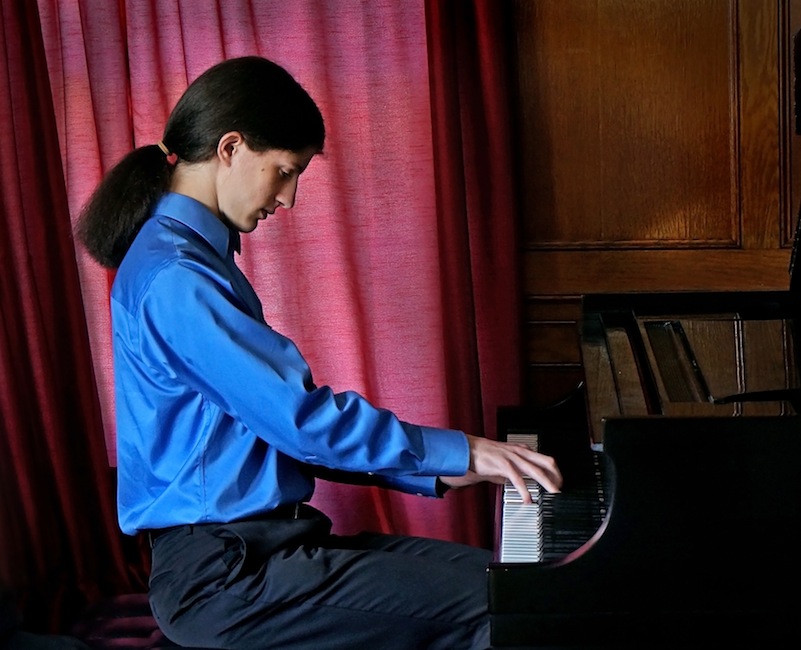Pianist Liam Kaplan in Review
Liam Kaplan, piano Mannes College, The New School for Music, New York September 28, 2013Bach-on-the-piano activism is not the eyebrow raiser it once was. The tenet that J. S. Bach’s lifetime of keyboard works dealt only marginally with a plinky-hammered, Lilliputian forebear of a concert grand has been superseded, even among retro-fashionable harpsichordists and clavichordists, by the iconic status of the music and the deferential acknowledgment of equal access, if not equal temperament, to all performers who wish to claim it as their own. Now that the activists are at peace, the spotlight has shifted back to its original point, a discussion of the tuning systems which unlocked music forever when Bach composed his eloquent and sprawling “Well-Tempered Clavier.”
Temperament is a deliberate sweetening or souring of ordinarily pure consonances by a keyboard tuner, who distorts certain intervals slightly in order to retain the usable intonation of all twelve different notes in the octave. The choices of notes to mistune would determine the most aesthetically permissible keys through the centuries, but pieces had to stay near the keys related to the sweet notes or the instruments would have to be retuned around new keys. The search for a single operating system which could service all keys at once was so hotly argued that eventually the whole case was settled by the discovery of the twelfth root of the number two, an all-purpose multiplier for each note’s pitch in order to reach that of its northern neighbor, and no one has ever looked back. Meanwhile, on the sly, Bach safeguarded the family heirloom temperament and displayed the sacred formula not as a Wall Street pie chart but as a doodle on the title page of his book, according to the musical cryptographer Bradley Lehman and his supporters. Simple and harmonious, tuned in fifteen minutes, centered around B major, Bach’s Good Temperament distributed the tartness little by little en route to the brighter keys, stressing the recognized Affekt or emotion inherent to each of the twelve major and twelve minor tonalities. (Modern expense prohibits the use of Bach’s temperament in a usual recital setting.) The live demonstration in 1722, a prelude and fugue played in every one of twenty-four keys, landed Bach a teaching job in Leipzig and a demand for a spin-off collection of twenty-four even more complicated preludes and fugues. Chopin liked to warm up with them.
Fifteen-year-old Liam Kaplan is the latest candidate to have traversed Book One of “Das Wohltemperierte Klavier” in a single concert, at the Mannes College on Saturday evening. An unavoidable intermission bisected the majesty of the marathon but refueled the artist’s prodigious memory. Young Mr. Kaplan, a composition and bass student as well as a pianist at Mannes Prep, is finding his adult voice in a milieu rich with possibility. His inborn gifts of Swiss-watch rhythmic pulse, polyphonic lightness, and formal proportion were obvious from the start. Mr. Kaplan hears like a composer, albeit a rare composer who tells time and who communicates motives as well as harmony. He relishes excursions and surprises, layered balances, extended sequences and coda sections. Many of his performances could be lifted directly into a music history survey with complete satisfaction. Mr. Kaplan draws the listener into his world, a place of discipline and dignity, of sunny and attainable ideals. Although he seems as yet untouched by sorrow or even the theatrical portrayal of darkness, suspended in his refined atmosphere of feathery pointillism and trotting tempos, Mr. Kaplan is eminently likable. Some questions ensue if we fall captive to the cerebral perfection of his fugues in C-sharp minor or A major, or the expertly tailored articulation of his whirlwind preludes in G major and frothy B-flat: at the end of the day, Mr. Kaplan prefers to coax only a mezzo-piano out of a nine-foot Steinway. He seems not to need power or tragedy, to distinguish a poignant tonality from a soothing one, or to play a piano like an organ. He spreads chords ahead of their beats and crushes his leaning grace notes without spice. He is humble and happy not to show off.
Time will tell, of course. To evince such an abundance of fundamental musicianship at fifteen is no small feat. The self-control in Mr. Kaplan’s work is a proven predictor of success and a quality that few performing artists can hang on a shingle. In comparison with the rowdy boys in Bach’s charge at the St. Thomas School in Leipzig (some of whom burned mice over a candle and left them as trophies for the professor), Liam Kaplan might have made Bach a very proud mentor.

